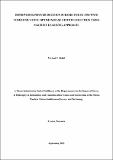Improved handover decision scheme for 5g mm-wave communication: optimum base station selection using machine learning approach.
Abstract
The rapid growth in mobile and wireless devices has led to an exponential demand for data traf fic and exacerbated the burden on conventional wireless networks. Fifth generation (5G) and
beyond networks are expected to not only accommodate this growth in data demand but also
provide additional services beyond the capability of existing wireless networks, while main taining a high quality-of-experience (QoE) for users. The need for several orders of magnitude
increase in system capacity has necessitated the use of millimetre wave (mm-wave) frequencies
as well as the proliferation of low-power small cells overlaying the existing macro-cell layer.
These approaches offer a potential increase in throughput in magnitudes of several gigabits per
second and a reduction in transmission latency, but they also present new challenges. For exam ple, mm-wave frequencies have higher propagation losses and a limited coverage area, thereby
escalating mobility challenges such as more frequent handovers (HOs). In addition, the ad vent of low-power small cells with smaller footprints also causes signal fluctuations across the
network, resulting in repeated HOs (ping-pong) from one small cell (SC) to another.
Therefore, efficient HO management is very critical in future cellular networks since frequent
HOs pose multiple threats to the quality-of-service (QoS), such as a reduction in the system
throughput as well as service interruptions, which results in a poor QoE for the user. How ever, HO management is a significant challenge in 5G networks due to the use of mm-wave
frequencies which have much smaller footprints. To address these challenges, this work in vestigates the HO performance of 5G mm-wave networks and proposes a novel method for
achieving seamless user mobility in dense networks. The proposed model is based on a double
deep reinforcement learning (DDRL) algorithm. To test the performance of the model, a com parative study was made between the proposed approach and benchmark solutions, including a
benchmark developed as part of this thesis. The evaluation metrics considered include system
throughput, execution time, ping-pong, and the scalability of the solutions. The results reveal
that the developed DDRL-based solution vastly outperforms not only conventional methods but
also other machine-learning-based benchmark techniques.
The main contribution of this thesis is to provide an intelligent framework for mobility man agement in the connected state (i.e HO management) in 5G. Though primarily developed for
mm-wave links between UEs and BSs in ultra-dense heterogeneous networks (UDHNs), the
proposed framework can also be applied to sub-6 GHz frequencies.

